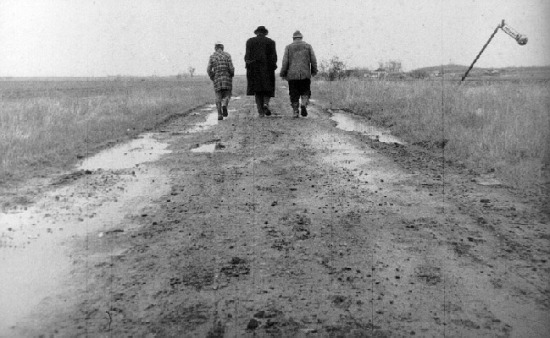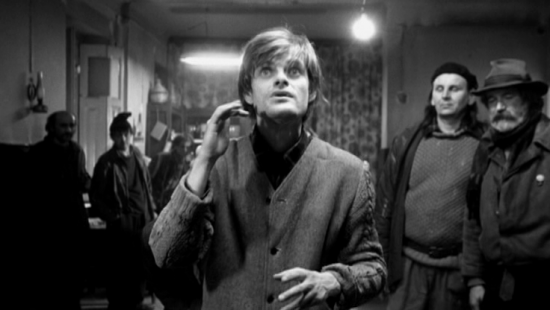The Camera is a Machine
by Gus Van Sant
I have been influenced by Béla Tarr’s films and after reviewing the last three works Damnation, Satantango, and Werckmeister Harmonies, I find myself attempting to rethink film grammar and the effect industry has had on it. This is the way I see it. Cinema started as simple single-shot full-length proscenium compositions resembling theater, the only thing that it could find to reference to commercialize itself. By the next twenty years there was a new vocabulary. The close up, montage, and parallel storytelling fragmented the continuity of the previous proscenium-encased static-frame full-figure images. Separate fragments were now placed together to form meaning, the director could play with time and cinematic space. It was exciting. Was this an absolute inevitable direction or just one road cinema chose to take?

I believe these cinematic innovations complimented industry and created an Industrial Vocabulary. The director could tell you how to think about scenes by the way he played with separate pieces. He could control his characters, he could control time and story, and he could control you. Left behind were the proscenium and the static take, which were old-fashioned.
Things were modern, things were easier, like doing your laundry, there was a washing machine now that would do it for you. The modern cinema was an invention that could think for you, you didn’t have to do in anymore, like in the theater.
The Cinema of Industry has progressed into mega-industry and mega-cinema but remaining ideally the same? The cinematic vocabulary of a 2001 television show like Ally McBeal is virtually the same as Birth of a Nation’s. It is no surprise that Citizen Kane has been considered the greatest film of all time, a film about selling oneself down the river along with the copper, coal and timber while nostalgically longing for a lost Victorian era, and film vocabulary’s original beginnings, a Rosebud, that has been left behind in another century.

Béla’s stuff seems to be a successful and authentic departure, a wholly other cinema beginning over again. A cinema that needed to come from outside our Western Culture, a lost Rosebud, one of the many directions cinema might have before we sold ourselves down the river.
Béla’s creations use static full figure landscapes, as if referencing the 1800′s steam engine pulling into a station that would force audience members standing in the gallery to run for the exit so they wouldn’t get hit by the train. Somehow Béla has gotten himself back there psychically and learned things all over again as if modern cinema had never happened. An angry crowd marches down a street to burn down the hospital in Werckmeister Harmonies, a shot that lasts about five minutes. When asked after a screening why the shot of the crowd lasted for so long, Béla answered, “ because it was a long way.” The question was an honest one, why would the audience weaned on post modern industrial cinema sit and watch an angry mob for so long when they have been used to a shot that lasts only a couple of seconds, even a shot ten or fifteen seconds would be too long. But the answer, although funny, is also an honest one, it was a long enough way that to show it for five minutes it affects the way we think about the event, the mob, the march, the hospital. Not shorthanded, not as clipped as in Industrial Vocabulary, but played out lyrically and poetically, letting us in on the thoughts rather than just saying one thing like, the mob walked, rather; the mob walked, and grimaced and raised their torches, and walked in synchronized and unsynchronized steps, advanced, fell back, and when they arrived it had been a long way.

Hitchcock said in response to a question by Francois Truffaut that major stylistic film changes could happen through character, perhaps, but here is a very major change through ideas.
Béla’s works are organic and contemplative in their intentions rather than shortened and contemporary. They find themselves contemplating life in a way that is almost impossible watching an ordinary modern film. They get so much closer to the real rhythms of life that it is like seeing the birth of a new cinema. He is one of the few genuinely visionary filmmakers.
MoMA Bela Tarr Retrospective Catalogue, 2001

